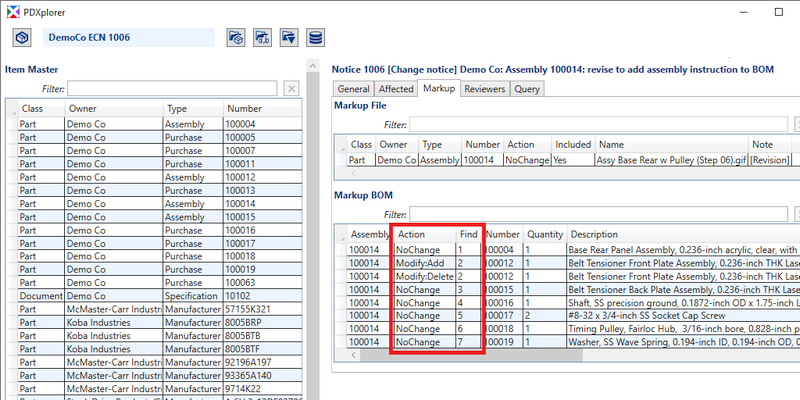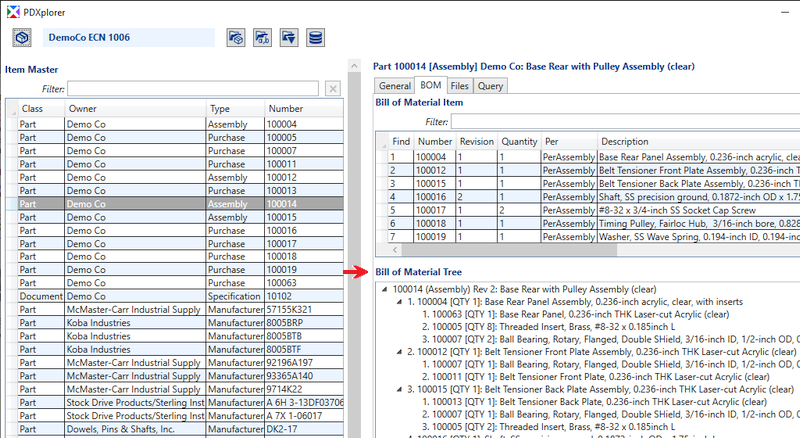PDXpert PLM Software
Application Note
BOM compare: Software for comparing all product data
Last update 2020-05-15
Comparing Excel BOMs is obsolete
Until now, spreadsheets have been used as the principal means for communicating the product structure. It's not that Excel is very good for comparing bills of materials, it's just that there's been nothing better.
Although comparing spreadsheet BOMs is very useful, the available data is extremely limited:
- Part numbers
- Quantity, perhaps with unit of measure
- Reference designators
- Maybe routing info or other application notes
- Possibly a small selection of approved sources for some components
Since BOM spreadsheets are commonly used within your supply chain, accuracy and completeness are essential. Finding all revised data in a multi-level BOM is equally critical.
However, anyone who's had to create and maintain spreadsheet BOMs knows that
- Spreadsheets are really bad at modeling an indented BOM, and
- Comparing BOM changes isn't the same as comparing changes to BOMs, approved sources and design files.
PDX: Better than a spreadsheet for product data
The best BOM compare tool would show much more than just a simple bill of materials. Let's also consider:
- Multi-level expansion of indented BOMs
- Part-level attributes like UOM, cost, package quantity, mass, material composition, custom attributes
- Revision-level data like current approved revision, lifecycle, detail drawings, trustee, release date and change number, and revision notes
- Approved part sources with supplier contact information
- Fabrication, assembly and supporting file attachments
- Engineering change release details
Fortunately, there's a standard file format that provides all of this information.
The IPC-2570 Supply Chain Communication (PDX) standard specifies a Product Data eXchange file (a "PDX package") that includes the complete product view: parts, BOMs, documents, design files, change notices, supplier contacts and a host of other useful information.
IPC-2570 defines two formats: the Manufacture and the ChangeNotification PDX packages. The ChangeNotification package made by PDXpert and similar tools includes change form details such as description and reviewers; items affected by the change; and markup (Modify:Add / Modify:Delete / NoChange) lists.
Exporting a PDX package from your PDXpert PLM or an MRP system is all we need. Well, we'd also need a PDX viewer that can read the PDX package....
PDXplorer understands your assembly changes
PDXplorer provides a simple way to navigate, view and export product data contained in PDX packages.
Change notice BOM markup
PDXplorer opens the ChangeNotification PDX file for viewing changes to individual items and BOMs.

Multi-level BOM
All PDX packages can include approved bills of materials. PDXplorer shows multi-level BOMs from PDXpert software packages and many other PLM/MRP tools.

PDXplorer features:
Completely FREE to download and use — for all of your supply chain partners.
Simple operation: just export a part, document or change PDX package from PDXpert or any PLM/MRP that supports the PDX format, and open it with PDXplorer... no reformatting, data crunching or cut/paste required.
Comprehensive product data: parts, BOMs, sources, document references, file attachments, material composition, custom attributes, change forms.
Industry-standard file format is vendor-neutral and application-independent.
-
Search filters to find parts, BOMs, sources.
Launch file attachments for viewing by simply clicking a button.
Export all files in the package, or just a selected file.
Select rows or entire grids to copy data into email or other software applications.
-
Run on your local PC, and avoid the slow performance and security risk of cloud-based tools.
-
Export items, BOMs, sources and other user-defined data in Excel-compatible CSV text files.
What's better, Excel+BOM spreadsheet or PDXplorer+PDX package? When you see the results, you'll discover there's simply no comparison!
This application note was relevant to the PDXpert software release that was current at time of publication. Product changes since that time may affect its utility. We'd be happy to assist you in assessing the applicability of this note to your situation.
Working within PDXpert
- Designing an engineering change process and workflow
- Server: Fast file content searches using IFilters
- Server: Scheduled backup for the database and library
- Server: Running several PDXpert Application Servers on the same network
- Batch Import: Preparing file attachments for import
- Batch Import: Converting a PDX package for PDXpert
- Batch Import: Keep settings, remove test item records
- Batch Import: Creating release sets for imported data
- Batch Import: Bulk replacing item attributes
- PDX package: Compare all product data, not just the BOM
- PDX package: IPC-2570 package implementation
- PDX package: IPC-2570 security signing and password extensions
- Adding a custom SQL Server report to PDXpert
- Adding a custom SQL Server report to PDXpert 8.0 to 11.2
- Designing email notice templates
- Including labor time and cost in assemblies
- Materials management for regulatory compliance
- Switching an existing item to a different type
- What's the difference between Item Revision State and Item Lifecycle Phase?
- Copying an assembly BOM to another assembly
- PDXpert permissions: User access design
Working with other software applications
- Using Altium Designer EDA software with the PDXpert client
- Using Altium Designer EDA software with the PDXpert server
- Using Cadence OrCAD Capture CIS with the PDXpert client
- Using Cadence OrCAD Capture CIS with the PDXpert server
- Using Pulsonix EDA software with the PDXpert server
- Importing a CAD bill of materials into PDXpert PLM software
- MRP/ERP data transfer options with PDXpert PLM software
- Exporting PDXpert PLM parts, BOM & sources to MRP/ERP
- Importing Trilogy Design Parts&Vendors data into PDXpert
- Exporting a bill of materials from PDXpert to Visio
